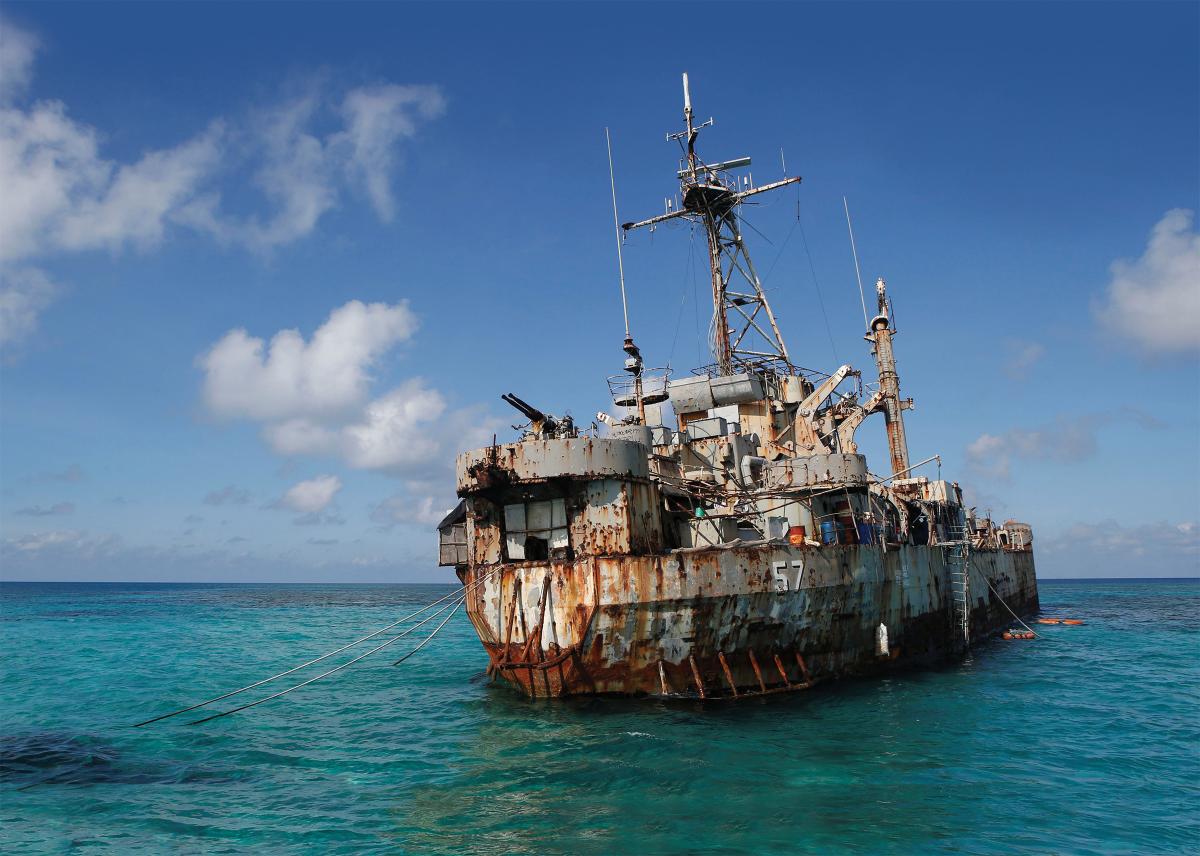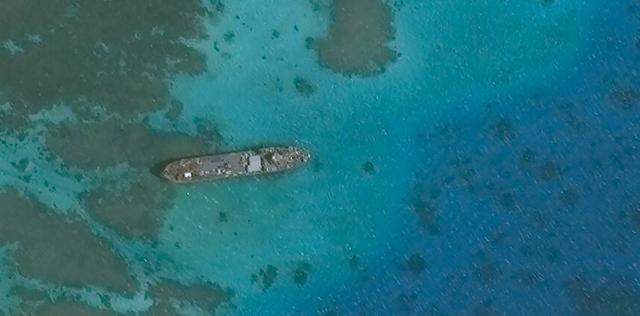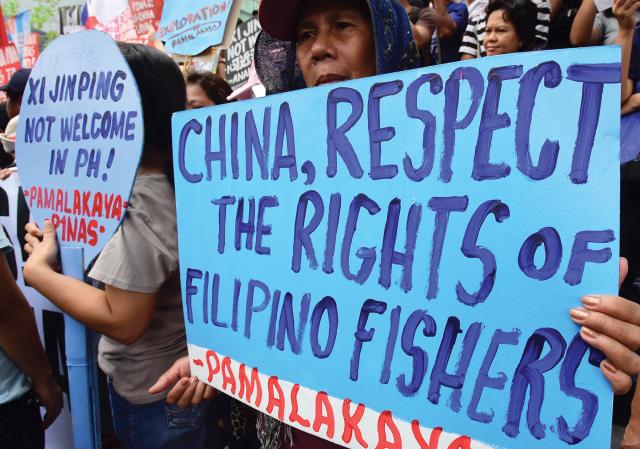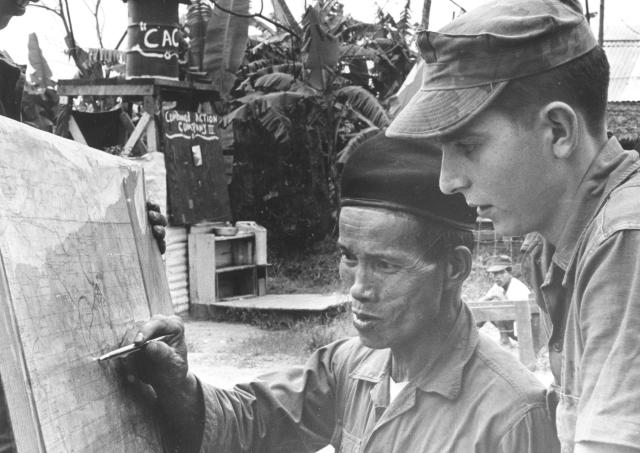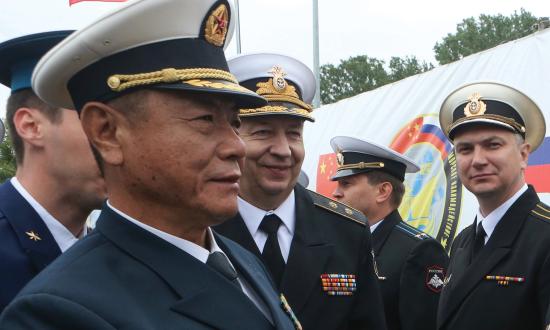Approximately 120 miles west of Palawan Island in the South China Sea, eight Philippine Marines stand at the front line of Chinese expansion. More than 20 years ago, the Philippines grounded the World War II-era landing ship Sierra Madre on a speck of coral known as the Second Thomas Shoal. This move was a signal that the island nation would stand against China’s territorial ambitions.1
Today, that ship sits rusting on a reef that is underwater most of the day. The men guarding it exist in a wide foreign policy gap between the United States and the Philippines. While current U.S. policy provides numerous options to counter Chinese activities in the South China Sea, most activity consists of freedom of navigation operations, with little direct confrontation. In addition, despite a longstanding counterterrorism partnership with the Philippines, the United States has done little to support that ally against Chinese influence and expansionism.
The United States and regional allies can do more. Responding with a kind of “irregular warfare” campaign could deter Chinese aggression while maintaining acceptable risk relative to potential escalation. Effective special operations and irregular campaigns would both demonstrate resolve to China and support the goals of the U.S. National Security Strategy.
Why the Second Thomas Shoal?
China is a net importer of energy. Its huge population and modernization efforts have driven growth in the country’s energy needs dramatically over the past decade. An estimated 80 percent of its oil imports pass through the Strait of Malacca, a choke point the United States could close in wartime.2 But in the South China Sea, China sees an alluring potential for energy independence. In 1989, its Ministry of Geology and Mineral Resources estimated that 17.7 billion tons of oil deposits (more than 100 billion barrels, although the U.S. Geological Survey estimate is closer to 30 billion) may exist in the Spratly region, which includes the Second Thomas Shoal.3 If correct, these estimates imply the area could contain the world’s fourth largest oil reserve.
China therefore is committed to countering Philippine efforts to maintain a presence on—and assert sovereignty over—the shoal. It is doing this in part through the People’s Armed Forces Maritime Militia, a network of fishing and research vessels described by one Chinese garrison commander as “an irreplaceable mass armed organization not released from production and a component of China’s ocean defense armed forces [that enjoys] low sensitivity and great leeway in maritime rights protection actions.”4 This undeclared, quasi-hostile force is regularly backed up by the China Coast Guard.
In 2010, China claimed the militia had 8 million members worldwide operating up to 143,000 vessels.5 As part of a global influence operation, the maritime militia provides a 24-hour encirclement of the Second Thomas Shoal, constantly monitoring the Philippines’ small contingent and interfering with resupply efforts, often ramming support and resupply vessels.6
Rather than distancing themselves from such aggressive and illegal tactics, Chinese officials encourage their forces to participate. The concept is referred to as the “Cabbage Strategy,” illustrated most effectively by Chinese General Zhang Zhaozhong, who coined the term:
The fishermen conduct normal production there. In the area around the island, fishing administration ships and marine surveillance ships are conducting normal patrols, while in the outer ring there are navy warships. The island is thus wrapped layer by layer like a cabbage. . . . For those small islands [held by other states], only a few troopers are able to station on each of them, but there is no food or even drinking water there. If we carry out the “cabbage” strategy, you will not be able to send food and drinking water onto the islands. Without the supply for one or two weeks, the troopers stationed there will leave the islands on their own. Once they have left, they will never be able to come back.7
Despite a long-standing alliance with the Philippines, the United States does relatively little to denounce China’s hostile actions. Fear of escalation has limited U.S. response to diplomatic complaints. Under the Obama Administration, in 2014 the United States entered into the Enhanced Defense Cooperation Agreement (EDCA) with the Philippines to demonstrate that nation’s strategic importance and U.S. resolve to deter Chinese expansion; President Barack Obama went so far as to describe that resolve as “ironclad.”8
Since then, however, U.S. resolve has been anything but. The risk of escalation from direct military intervention has been viewed as too great. The 2018 National Defense Strategy refers to these competition areas as the “contact layer,” and they are the key terrain in great power competition.9
Irregular Warfare
Joint doctrine broadly defines irregular warfare as “a violent struggle among state and non-state actors for legitimacy and influence over the relevant population(s).”10 The concept became a major U.S. policy focus during the John F. Kennedy administration because of fears that direct confrontation with a nuclear-armed adversary would potentially be disastrous.
The current definition (much debated and refined in recent years) focuses on the “violent” nature of this struggle but leaves out the important nonviolent aspects that are key to avoiding escalation. Much of the effect of irregular warfare comes from organizing civil resistance and highlighting the bad behaviors of the powerful toward the powerless. This is the key issue in the South China Sea.
In a nondoctrinal 2012 study, the RAND Corporation defined maritime irregular warfare as operations involving at least one irregular actor or tactic that aim to shape the maritime environment in at least one of three ways: (1) to prevent supplies or personnel support from reaching an adversary, (2) to increase the capacity of partner naval and maritime forces, or (3) to project tailored U.S. power ashore to directly confront adversary forces, when necessary.11
This provides a useful framework of suggested activities and addresses nonviolent strategies that could be helpful in the case of the Second Thomas Shoal.
Two examples from U.S. special forces history show that nonviolent irregular warfare is possible in the maritime domain, and could be successful again given populations with similar needs.
Operation Switchback. One of the most prominent examples of special operations forces (SOF) conducting irregular warfare is the Civilian Irregular Defense Group (CIDG) program in Vietnam. Originally a CIA paramilitary program, CIDG was transferred to Military Advisory Command–Vietnam (MACV) in 1963 as part of the overall wartime strategy. Its teams developed South Vietnamese irregular military units that undertook tasks such as village defense, intelligence and counterintelligence, raids, ambushes, and sabotage of enemy supply lines.12 The program demonstrated the human potential in civil defense: Irregulars can be trained and equipped at relatively low cost (the 1962 budget was $10 million—about $80 million today) to provide a significant force multiplier.13 CIDG supported defense in depth and augmented strike force capabilities for MACV commanders.
In the South China Sea, emulating CIDG—but with less emphasis on “hunter/killer” and more on the softer “observe and report” or “occupy/harass”—would be ideal. As with the CIDG, irregular forces today also potentially could provide a platform for developing clandestine and covert operational requirements, given the appropriate authorities and permissions. It is not the activities undertaken by the surrogate but rather the characteristics of the aggrieved state—and its willingness to resist—that determine success in irregular warfare.
Detachment 101. The Office of Strategic Services (OSS) established Detachment 101 in 1942 to conduct unconventional warfare. Its role was to harass Japanese forces in Burma—through sabotage of supply lines, espionage, and guerrilla warfare. The unit went to work from its base in northern India to develop, train, and manage surrogate forces behind Japanese lines in Burma. The results were significant, especially because they required very little U.S. presence compared with other engagements. According to the National Archives, Detachment 101 was responsible for killing more than 5,400 Japanese soldiers and wounding an estimated 10,000. It also was responsible for up to 75 percent of the intelligence supplied to Tenth Air Force, resulting in significant bombing campaigns, and as much as 85 percent of all intelligence provided to General Joseph Stilwell’s Northern Combat Area Command.14
Characteristics and techniques from Detachment 101 can be applied to the indirect action required in the South China Sea today. For example, Detachment 101 conducted most of its network command-and-control from outside the conflict space. This model would allow the United States to reduce the potential for direct conflict while maximizing its use of surrogates. A surrogate network makes attribution for responsibility difficult, even as it signals to China that the United States will remain committed to restraint.
Much of Detachment 101’s success centered on intelligence collection, a critical need in the vicinity of the Second Thomas Shoal. The guerrilla forces recruited by Detachment 101 were experts in their operational environments and enjoyed a competitive advantage relative to the terrain, as Filipino fishermen would today.
What Is to Be Done?
Robert Haddick explains what U.S. irregular engagement in the South China Sea might look like:
In the maritime realm, U.S. and partner maritime SOF. . . could expand the training and capabilities of local maritime SOF, naval forces, and civilian maritime security forces. Such training and support could be expanded from orthodox maritime security force assistance by extending such assistance to “maritime militia,” civilian fishing fleets and other craft that are organized (as does China) into flotillas that pursue or counter maritime territorial objectives.15
While overt security force assistance certainly has merit, SOF are better positioned to pursue the civil assistance Haddick mentions. By training fishermen, water ferrymen, and others with maritime access, SOF can provide a necessary counter to China’s maritime militia, while allowing time and space for diplomatic or economic intervention. This indirect engagement would give U.S. policymakers time to catch up with more conventional interventions.
Taking after the concept of the CIDG, SOF can train and develop maritime assets to act as sensors to better understand Chinese activities and inform decision makers. In addition, these assets can act as a “neighborhood watch” against China’s own covert intervention to capture and deliver evidence of Chinese harassment. Presenting such evidence on the world stage is critical to begin developing an effective strategy aimed at communicating China’s bad behavior. Last, these maritime assets can provide a vehicle (when appropriate) for riskier, more sensitive SOF activities to increase the complexity of decision-making for ship commanders of the China Coast Guard and People’s Liberation Army Navy. Essentially, the goal is to reduce the freedom of maneuver these vessels enjoy currently—without direct U.S. involvement—through network operations.
Detachment 101 and CIDG had disproportionate and devastating effects against a large enemy, and the same principles that shaped them apply to gray zone competition today. The goal of intervention is not to break China, but rather to make Chinese occupation/exploitation of the Second Thomas Shoal and similar contested terrain more difficult and costly and take longer. This pressure, when incorporated into a broad, theaterwide campaign, could provide the United States a competitive advantage in the SCS without leading to direct confrontation.
Broken Portholes
There is no question the United States needs a new strategy for engaging China in the vicinity of the South China Sea to address the requirements laid out in the National Security Strategy. Under the status quo, China has no incentive to reduce or stop its activities. This leaves the United States and the Philippines in an area of uncertainty regarding the mutual-defense treaty, and lack of engagement only encourages further Chinese aggression. U.S. disengagement is a clear example of the “broken window” theory: “Untended property becomes fair game for people out for fun or plunder and even for people who ordinarily would not dream of doing such things.”16
In essence, the longer an area or entity is left untended, the more apparent it is to an aggressor that no one cares about it. At the Second Thomas Shoal, eight Filipino Marines are hardly a strong message to China that the Philippines and the United States care about the shoal. U.S. passivity has emboldened China to act; this was not the deal made in the mutual-defense treaty.
Failure to deter Chinese aggression invites the risk of direct confrontation when China inevitably decides to lay claim to the island. In 2019, Philippines President Rodrigo Duterte called on the United States to “gather the fleet” as a response to the Chinese Maritime Militia’s sinking of a Philippine fishing vessel in the Spratly chain.17 U.S. inaction in response to such calls only delegitimizes agreements with other partners and allies in the region and invites continued “cabbage strategy” tactics. The perception that the United States follows through for its allies is the cornerstone of extended deterrence and, more broadly, the nation’s foreign policy strategy worldwide.
Already there are debates as to whether the United States is “in retreat.” The country can ill afford further doubt as to its resolve, especially in an area as critical as the western Pacific. But neither can it go to war over such transgressions, least of all against a nuclear-armed adversary whose economy is so intertwined with its own. Instead, it must become more comfortable with employing the tactics of irregular conflict, because its adversaries certainly are. And they are winning.
1. Jeff Himmelman and Ashley Gilbertson, “A Game of Shark and Minnow,” The New York Times, 24 October 2013.
2. Marc Lanteigne, “China’s Maritime Security and the ‘Malacca Dilemma,’” Asian Security 4, no. 2 (29 April 2008): 143–61.
3. Michael Leifer, “Chinese Economic Reform and Security Policy: The South China Sea Connection,” Survival 37, no. 2 (June 1995): 44–59.
4. Andrew Erickson and Conor Kennedy, “China’s Maritime Militia,” Center for Naval Analyses (undated).
5. Erickson and Kennedy, “China’s Maritime Militia.”
6. Bonnie S. Glaser, “Conflict in the South China Sea,” Council on Foreign Relations (April 2015).
7. Michael Tkacik, “Understanding China’s Goals and Strategy in the South China Sea: Bringing Context to a Revisionist Systemic Challenge—Intentions and Impact,” Defense & Security Analysis 34, no. 4 (2 October 2018): 321–44.
8. Aileen S. P. Baviera, “Implications of the U.S.-Philippines Enhanced Defense Cooperation Agreement,” Asia Pacific Bulletin: Washington, no. 262 (9 May 2014): 1–2.
9. James Mattis, Summary of the 2018 National Defense Strategy, January 2018.
10. Department of Defense, DOD Dictionary of Military and Associated Terms (Washington, DC: 2020).
11. Molly Dunigan and National Defense Research Institute (U.S.), eds., Characterizing and Exploring the Implications of Maritime Irregular Warfare (Santa Monica, CA: RAND, 2012).
12. Donald P. Gregg, Thomas L. Ahern Jr., and Donald P. P. Gregg, Vietnam Declassified: The CIA and Counterinsurgency (Lexington, KY: University Press of Kentucky, 2009).
13. Gregg, Ahern, and Gregg, Vietnam Declassified.
14. National Archives and Records Administration, The Secrets War: The Office of Strategic Services in World War II (Washington, DC: 1992).
15. Robert Haddick, How Do SOF Contribute to Comprehensive Deterrence? (Joint Special Operations University, 2017), 62.
16. James Wilson and George Kelling, “Broken Windows,” The Atlantic, March 1982, 18.
17. “Duterte Invokes US Defence Pact over South China Sea Row,” South China Morning Post, 17 July 2019.



